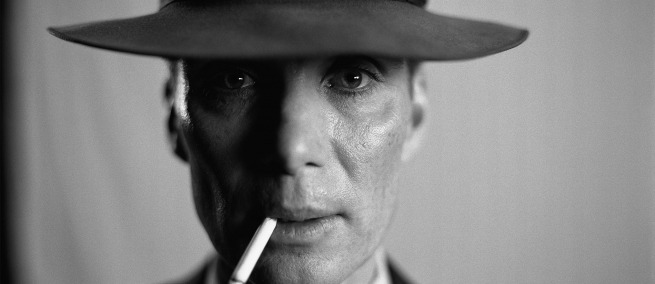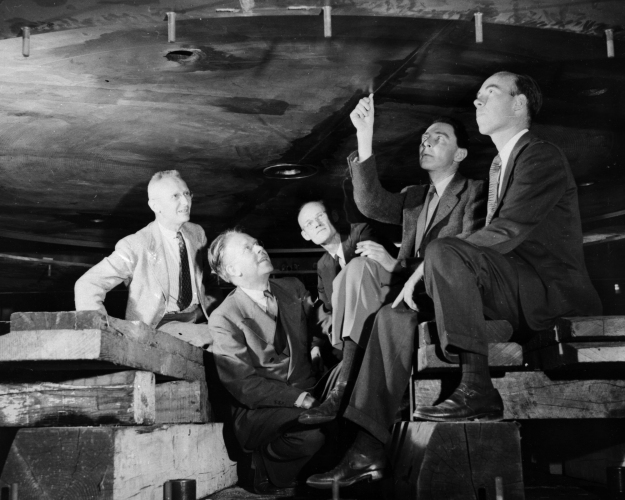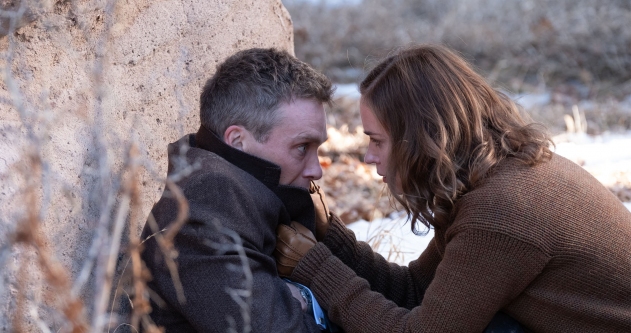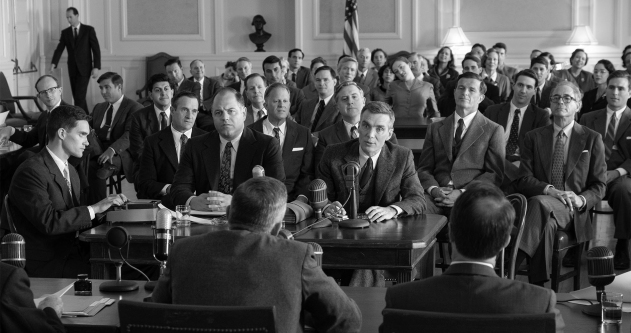
The film OPPENHEIMER that opened in theaters on July 21 relates a story that, decades later, still fascinates. It tells of physicist J. Robert Oppenheimer’s personal and scientific life that culminated when he spearheaded the scientific effort at Los Alamos that led to the atomic bomb and its military use in 1945, the last major action of World War II. These topics have been covered on screen before, notably in the documentary THE DAY AFTER TRINITY(1981) and the Hollywood drama FAT MAN AND LITTLE BOY (1989). OPPENHEIMER also takes us through the science and the history that generated the bomb, but it focuses on Oppenheimer as a man who gave his country and its government a great gift, if a dangerous and perhaps untamable one, and was repaid by being dishonored by that very same government.
If this reminds you of Prometheus, who was punished by the Olympian gods for stealing fire and giving it to humanity, you’d be right. The myth is cited at the beginning of the film, which is based on the book American Prometheus: The Triumph and Tragedy of J. Robert Oppenheimer (2006) by Kai Bird and Martin J. Sherwin. This biography won the Pulitzer Prize for its study of a gifted scientific leader with a complex, often contradictory personality. In the film, Oppenheimer is portrayed by Cillian Murphy, whose facial structure and subtle expressions reflect Oppenheimer’s physical look and complicated inner nature.

Press visit to the 184-inch cyclotron. Left to right: Donald Cooksey, Ernest Orlando Lawrence, Robert Thornton, J. Robert Oppenheimer, and William Brobeck taken in the spring of 1946. Photographer: Donald Cooksey.
Much of the film relates Oppenheimer’s rise and fall to his cultural and personal background. We see him as a clumsy experimentalist at Cambridge University who becomes so hostile to his tutor that he leaves him a poisoned apple. He turns to theoretical physics and is enthralled by the new quantum physics arising in the 1920s and 1930s. He learns about quantum theory from European pioneers such as Max Born and Werner Heisenberg, and on returning to the U.S. is in demand for academic positions. In 1942, he meets General Leslie Groves (Matt Damon), the bluff hard-driving engineering officer who chooses him as director of the facility that would build the bomb. Oppenheimer suggests New Mexico, which he knows and loves, as a remote site for the secret project, and the Los Alamos Laboratory and town are quickly built near Santa Fe.
One thread of the story takes us through the Los Alamos effort, showing some of its important scientific moments such as the development of methods to rapidly produce critical mass in a bomb; the slow process of isolating enough U-235 and plutonium to make bombs (cleverly represented visually as marbles being added little by little to fill glass goblets); and some initial calculations suggesting a not-quite-zero probability that setting off the bomb would ignite the Earth’s atmosphere. We meet other eminent scientists involved in the effort, such as Edward Teller, who invented the idea of the hydrogen bomb; and Richard Feynman, who would go on to a Nobel Prize for his work in quantum theory, playing bongo drums in a brief cameo.

Still from OPPENHEIMER
With a build-up of dramatic tension, we see the race to complete and test the bomb so that U.S. President Harry Truman, knowing its power, could demand the unconditional surrender of the Japanese government. The first atomic bomb test explosion at Alamogordo, New Mexico on July 16, 1945, is presented in the film as a silent moment of searing white light, followed by a roaring Niagara of sound. After the test, we learn of the atomic bombing of Hiroshima and Nagasaki as Oppenheimer did, on the radio. Germany had already lost the European war, and the surrender of Japan after the bombing definitively ends World War II. Oppenheimer is hailed at Los Alamos and nationally as a hero, although he has complex feelings about his role in atomic destruction.
But that’s not the end of the story, for the most important thread in the film shows how “hero” became reduced to “traitor” in the eyes of the American government. Woven through the other narrative threads, at various times in the film we see scenes of a secret 1954 meeting of a panel from the Atomic Energy Commission (AEC) to consider Oppenheimer’s security clearance. Los Alamos scientists had to have a high-level government security clearance, with one particular fear being incursion of spies from the Soviet Union, our ally in the war but not trusted under its Communist regime.
This is where Oppenheimer’s personal past carries great weight. As the film shows, in his younger days he had contributed to causes that, by the 1950s, the era of McCarthyism, were viewed with suspicion and alarm. His brother, wife, and some associates had belonged to the Communist Party. In 1943, while Oppenheimer was directing the bomb project, security agents trailed him to San Francisco where he continued an affair with a lover who was active in the Communist Party. These supposed signs of disloyalty would have been taken seriously except that Oppenheimer was essential to the project. But as the film shows, the classified security information was later covertly released by an enemy Oppenheimer had made in the government. This led to the AEC hearing.
Oppenheimer’s Communist links raised questions about his loyalty to the U.S. He also favored international control of nuclear weapons and opposed the development of the hydrogen bomb. As depicted in the film, Edward Teller testifies at the hearing that he lacks confidence in Oppenheimer’s leadership. Another ex-colleague, Ernest Lawrence who invented the first atom-smasher, the cyclotron, is shown as ready to deliver further negative comments. And as we watch Oppenheimer’s testimony, we realize that his combined naiveté and arrogance, and his inconsistent responses, make him unconvincing in his own defense. But although there is no evidence that Oppenheimer ever joined the Communist Party, the panel votes two to one to revoke his security clearance, ending his career in nuclear science and any moderating influence he might have over national nuclear policy. This is the true climax of the film, which does not dwell on Oppenheimer’s life after the decision.

Still from OPPENHEIMER
From my own experience, I know that the scientific community considered this hearing a travesty and continued to revere Oppenheimer. He came to speak at the University of Pennsylvania in the 1960s, when I was a graduate physics student there. I had to stand at the back of a large auditorium at Penn, which was overflowing with those eager to hear him. Aware that he had a life-long interest in religion, especially Hinduism, I recall that he looked finely drawn, as if his experiences in building the bomb and suffering the consequences had refined him down to some essential spiritual core.
At 180 minutes, Christopher Nolan’s OPPENHEIMER runs longer than THE DAY AFTER TRINITY or FAT MAN AND LITTLE BOY, which tell the main aspects of the same story. There is value in retelling the story today at greater length, much of which is due to the detailed coverage of the people and events surrounding Oppenheimer’s treatment by the government in 1954. That treatment is an example of the twisting of truth about science and scientists for political or other reasons that we see today in arenas such as the science of climate change and of the COVID pandemic. It’s important to remind the current generation that the tension between science and politics has a long history and is not going away. If it led to a personal tragedy for Oppenheimer, it could lead to greater tragedies for the U.S. and the world.
♦
Epilogue: In December 2022, 55 years after Oppenheimer’s death in 1967, largely due to the efforts of the authors of American Prometheus, U.S. Secretary of Energy Jennifer Granholm (whose department succeeded the AEC) announced that she had “nullified a 1954 decision to revoke the security clearance of J. Robert Oppenheimer” to correct the record and honor his “profound contributions to our national defense and scientific enterprise at large.”
Personal note: Besides seeing Oppenheimer speak, I had direct experience of Los Alamos when I worked there as a student researcher in the early 1960s. Like Oppenheimer and all the scientists, I had a high Q-level security clearance. My field was not nuclear physics, and I studied a problem in fluid dynamics, but echoes of the atomic bomb effort lingered 15 years later. My boss two levels up had been important in the development of the hydrogen bomb, and another senior member of the group had helped to design the atomic bomb. I heard stories about scintillating contests of brilliance between the world-class scientists gathered there, and about Richard Feynman, who enjoyed leaving notes in supposedly secure locations to show that he had found a way to enter them. While some of this is shown in the films I mention here, none of them captures the unearthly beauty and spirit of Los Alamos. It lies at an altitude of 7,300 feet in thin, perfectly clear air and under brilliant New Mexico sunshine. Across the valley, the Sangre de Cristo mountains glow red at sunset and sometimes capture lightning strikes during summer storms. In this environment, it’s easy to feel that extraordinary things could happen, and they did.
TOPICS